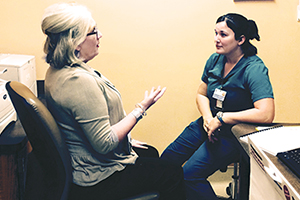By JULIE MINDA and KATHLEEN NELSON
Wrench, pipe cutter, plunger: a plumber uses these tools to break down a clog and create an open flow of water through a house. Nancy Cook has created tools on a higher plane, encouraging employees at CHRISTUS Health Southeast Texas to break down barriers and create an open flow of communication that improves work conditions and, ultimately, a patient's experience.

Nancy Cook, left, regional director of spiritual care for CHRISTUS Health Southeast Texas, interviews an employee as part of the Team Well-Being Measure, a spiritual tool to help improve communication and working conditions within units of the health system.
"As a chaplain, I ask, 'What is my piece? What can I do for patient satisfaction?'" said Cook, regional director of spiritual care for CHRISTUS Health Southeast Texas in Beaumont. "I can address the associates. I know I can have an immediate effect on them."
Cook has developed, even copyrighted, the Team Well-Being Measure, a means of assessing and improving employees' emotional and spiritual wellness. She refers to Team Well-Being as a tool, and her experience with employees, referred to at CHRISTUS as associates, hammers home this point: improving the well-being of associates can raise satisfaction and performance.
"They have a sense of purpose when they see how they're connected. And any barriers that prevent them from being connected, we identify them and as best as possible remove them," Cook said. "We also know that when our associates are satisfied, they provide better patient care, patient satisfaction scores go up. So it's all connected."
Cook forged the tool in 2012, basing it in large part on a pair of human growth and development models: Enneagram, which divides human personality into nine types; and the writings of Jesuit philosopher Fr. Bernard Lonergan. She then created four steps in the Team Well-Being process.
Initiation: A unit director or supervisor asks Cook to administer the tool. Among the keys to success is participation of at least 80 percent of the employees in the unit, a goal which requires a deft touch.
"If it's not, then it's weak," Cook said. "But we don't say 'mandatory.' We say, 'We strongly encourage everyone to participate.'"
The unit director works with Cook to establish a timeline and develop initial survey questions. Cook then explains the process to staff and administers an individual personality assessment to each employee.
Issues: Employees identify departmental issues that impact well-being. Cook reviews the responses to develop 12 to 16 interview questions.
Interviews: Cook conducts one-on-one interviews with employees.
"Sometimes people have an idea that's not fully formed but has high emotion associated with it," Cook said. "Maybe it's a perception. So, when they go through this process, they work more fully into it and the emotion is reduced because they've had a chance to think it out."
After compiling this feedback, Cook prepares individual personality reports as well as a metric summary and a verbatim report for the group.
Interventions: The team gathers to discuss the summary report and to suggest improvements based on strengths, rather than weaknesses. The unit director then has to follow through with solutions and reports on the outcomes.
"I deliver what the associates are identifying as barriers to well-being in the workplace," she said. "Ultimately, it's the director's responsibility to come up with interventions for themselves."
Cook said 15 units, or 304 employees, at CHRISTUS Health Southeast and two business partners had volunteered to participate. Units that used the tool reported that employees' satisfaction score improved by an average of 14.4 percent. About 90 percent of the participants said the process successfully identified the underlying source of conflict, and 95 percent said the process allowed for giving honest feedback.
The tool uncovered two issues as barriers to well-being in the oncology department. The director's schedule was included in the staffing matrix for the west side of the unit but not in the matrix for the east side, leading to a perception that the director worked only on the west side and to feelings of inequity. Patricia Morrell, director of nursing, adjusted her schedule to split her time evenly between the units.
The staff also agreed that performing phlebotomies had become time-consuming. At Morrell's suggestion, CHRISTUS hired a technician specifically to draw blood from oncology patients.
"I feel that the tool is an important one in understanding the teamwork of the unit and to identify opportunities for improvement," Morrell said. "I would definitely participate in this process again because staff and circumstances change over time."
The surgical unit used the tool to help in a leadership transition.
"It helped us to focus on the big picture," said Dennis LeBlanc, a registered nurse who is the hospital's director of surgery. "It helped me understand how I was being perceived by those who looked to me as their leader. What I like best about the tool is that it provides a platform for those things difficult to discuss."
Because of the tool's success, Cook has developed a workshop that she presented at the National Association of Catholic Chaplains conference this year in Arlington, Va., and at the MedAssets annual conference in Las Vegas. CHRISTUS also has made use of the tool a best practice system wide. The recognition that means the most to Cook comes from employees who report a deeper understanding and sense of purpose.
"When they have purpose, they have their own sense of fulfillment and provide good patient care," Cook said.
Copyright © 2015 by the Catholic Health Association
of the United States
For reprint permission, contact Betty Crosby or call (314) 253-3477.